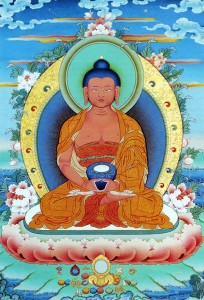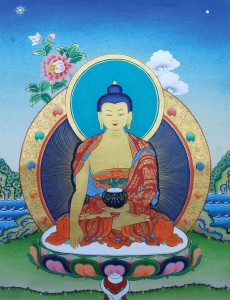For non-Buddhists, and even for some Buddhists, it’s sometimes hard to tell the difference of what buddha statue is of what buddha. Depending on the country and school of Buddhism the statue is at, that’ll give you a small clue, otherwise, it’s usually the gestures (mudras) that buddhas are making that make it possible to tell what buddha that is. According to Buddhists texts, there are an immeasurable number of buddhas in all directions, but the most venerated buddhas are Shakyamuni Buddha, Amitabha Buddha, Medicine Buddha, and Vairocana Buddha.
Amitabha Buddha, Buddha of Infinite Light, is a celestial buddha in Mahayana Buddhism. Amitabha is the principal buddha in Pure Land Buddhism, mainly practiced in East Asia. Amitabha created his Pure Land called Sukhāvatī, where as part of his vows to become a buddha (his eighteenth vow), everyone is guaranteed into his Pure Land if they call upon his name as few as ten times. Visualizing Amitabha’s Pure Land and reciting his name during meditation, and reciting his name upon death, are the techniques used to be reborn in the Pure Land.
Amitabha’s statue is often shown him seated in meditation holding an alms bowl with both hands.
Our historical Buddha, Sakyamuni Buddha (or Gautama Buddha) is the founder of Buddhism. Born some 2600 years ago, Sakyamuni found the Middle Way of living in order to attain liberation from the suffering/dissatisfaction of life.
Sakyamuni Buddha’s statue is often shown him seated in meditation holding an alms bowl with his left hand, and his right hand touching the earth.
Vairocana Buddha is another celestial buddha who is seen as the embodiment of the Buddhist concept of emptiness. He is also mentioned as an epithet of Sakyamuni Buddha in the Sutra of Meditation on the Bodhisattva Universal Virtue, who dwells in a place called “Always Tranquil Light.” Vairocana is first mentioned in the Brahma Net Sutra. He is also mentioned in the Flower Garland Sutra, Mahavairocana Sutra, Vajrasekhara Sutra.
Vairocana Buddha’s statue is often shown him seated in meditation with one of three gestures (mudras): dharmacakrapravartana (gesture of teaching), vajramudra (gesture of knowledge fist), or uttarabodhi (gesture of perfection).
Formally known as “Bhaiṣajyaguruvaiḍūryaprabhārāja,” Medicine Master and King of Lapis Lazuli Light, he is the Buddha of healing and medicine in Mahayana Buddhism. He is most commonly referred to as “Medicine Buddha” because he cures suffering using the medicine of his teachings.
Medicine Buddha’s statue is often shown him seated in meditation holding an alms bowl with his left hand, and right hand facing outwards holding a medicine herb.



